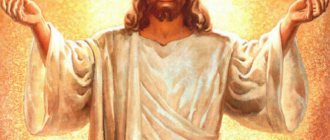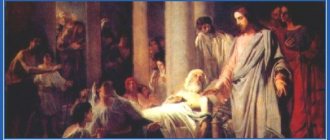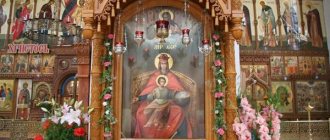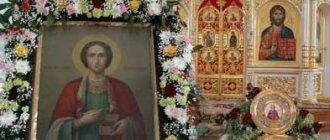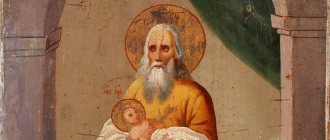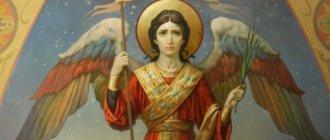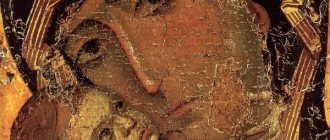Many instructive stories can be read in the writings of St. Demetrius of Rostov. He described the lives of many saints, including Stefanida of Damascus, whose icon is found in Orthodox churches. She lived and suffered in Damascus in the second half of the 2nd century, when Marcus Aurelius ruled.
About the author About the book
“Stephanida of Damascus” - an icon of Orthodox Christians
For most Christians, the icon of Stephanida of Damascus has become a sign of faith and struggle, which is carried out through pain and suffering.
This church relic concentrates all the power of the word of God, which points a person to his purpose and the truth of life, and helps him take the righteous path. “Stephanida of Damascus” is an icon that allows a person to concentrate all his inner will in order to be ready to sacrifice himself in the name of justice. Many righteous people revere it and study its history and meaning. These and other issues will be discussed in more detail in this article.
Icon “Stephanida of Damascus”: history
In 175, when Marcus Aurelius was reigning in Syria, one of his fighters named Victor, who was a true Christian, lived in the city of Damascus. He was ordered to offer sacrifice to idols, renouncing Christ.
But the warrior objected, shouting openly and loudly that he was a warrior of the King of Heaven and would honor only him alone. After the incident, the man was subjected to all kinds of torture. They broke his fingers, burned his body with fire, pulled out veins from a living person, poisoned him, and so on.
Victor endured all his torments with courage, never ceasing to pray to God. Despite everything, he remained alive.
The wife of one of the soldiers, who was called Stefanida, stood up for the warrior, glorifying his suffering. She was also a Christian, but in secret.
And when Stefanida of Damascus, whose icon is familiar to many, saw angels descending from heaven, she realized that she also needed to stand up for her faith in Christ. The executioners saw the young woman as a victim for torture. They tied her to two trees to dismember her body into pieces.
They attached one leg of the woman to the top of a tilted tree, and the other to the second one, and released them. When the trees rose in height, they tore Stefanida into two parts. The woman’s soul is like a bird that has freed itself from a trap and found refuge in heaven.
After all this, the executioners cut off Victor’s head. Thus, Stefanida and Victor of Damascus, having suffered for Christ, proved their faith in the Lord and showed everyone his miraculous power.
Meaning
The icon “Stephanidas of Damascus” helps the person who turns to it to understand himself, to realize himself as a person, thereby finding peace and tranquility.
The icon helps a believer to decide on his future life, to make it righteous until the very end.
Another distinctive feature of the icon is love for one’s neighbor, which determines the level of spirituality of people, because every Christian is ready to do a lot for the sake of justice, sometimes even to defend a stranger.
The miraculous power of the icon
Today many people come to the holy face, turning to it with various requests. The icon “Stephanidas of Damascus” is always waiting for everyone who asks. How this saint helps was discussed above.
It relieves a person not only from mental disorders, but also from physical ailments.
The holy face strengthens the will of people, helps to gain internal strength to fight both external enemies and internal demons.
“Stephanida of Damascus” is an icon that allows every Christian to understand the meaning of sacrifice in various life situations, adhere to their principles and views, and always be faithful to them.
Reverence
Victor and Stefanida of Damascus were killed on November 11, 175 in the city of Damascus. On this date, the memory of the holy great martyrs is still venerated. Their relics, according to some sources, are located in the city of Fano (Italy). Until this time they were stationed in Constantinople. You can see the icon in any Orthodox church, since it is part of the divine service.
Iconography
In Orthodox iconography, the martyr Stefanida is depicted as a young woman dressed in a blue tunic. Over the tunic is usually worn a red mantle in the form of a long veil, which is buttoned at the collar and goes down to the knees.
It symbolizes renunciation of idolatry, and its red color represents the torment of Stefanida, as well as the victory of life over death. The edges of the mantle are trimmed with a blue border. The blue tunic personifies the heavenly purity of the martyr and is a symbol of eternal peace.
A cross is usually placed in the hands of the great martyr.
The holy martyr Stefanida is depicted in the icon with her head covered, since even then a praying woman had to cover her head as a sign of the power of the angels over her. Thus, the covered head is evidence of the martyr’s presence in prayer and her disposition towards humility.
The white color of the material that covers the head symbolizes Divine light, purity, holiness and simplicity. Only righteous souls were clothed in white robes. A halo is visible above the martyr’s head - a radiance of light and Divine glory. He transforms a person who has united with God.
“Stephanida of Damascus” is an icon that has become a symbol of faith in the justice of many Christians. The Great Martyr is considered pure and wise, honest and righteous. Today, the holy face of Stefanida has helped many people find themselves, choose their path in life and righteously walk along it.
Source: https://allwomanday.ru/article/325470/stefanida-damaskaya—ikona-pravoslavnyih-hristian
Meaning
The icon “Stephanida of Damascus” helps the person who turns to it to understand himself, to realize himself as a person, thereby finding peace and tranquility. The icon helps a believer to decide on his future life, to make it righteous until the very end. Another distinctive feature of the icon is love for one’s neighbor, which determines the level of spirituality of people, because every Christian is ready to do a lot for the sake of justice, sometimes even to defend a stranger.
Holy Martyr Stephenida of Damascus
Holy Martyr Stephenida of Damascus
Image of the Holy Martyr Stephenida of Damascus Dimensions of arched icon cases: 18 x 22 x 5 cm - 2500 rub. 29 x 22 x 5 cm - 4000 rub.
45 x 60 x 7 cm - 20,000 rub.
Article No. Ж 0021
The holy martyr Stefanida of Damascus suffered for Christ along with the warrior Victor, who served under Emperor Marcus Aurelius the Philosopher (161–180). The holy martyr Victor refused to carry out the order of the emperor, did not make a sacrifice and did not worship the wicked gods.
Thus, in the opinion of the emperor, he did not pass the test of loyalty to the country and the emperor. The Emperor ordered the warrior to be tortured, but the Lord, by His mercy, showed a miracle and Victor remained unharmed. He was able to convince even the sorcerer to accept faith in Christ.
During the torment of the martyr, one woman named Stefanida, who came to see the torment of the saint, a Christian by faith and the wife of one of the soldiers, saw two beautiful crowns descending from heaven.
One of these crowns descended on the head of the holy martyr Victor, and the other on her.
Seeing this, Stefanida began to glorify the martyr in a loud voice:
“Blessed are you, Victor, and blessed are your sufferings for Christ, your sacrifice is acceptable to God, like Abel’s, because you offered yourself to Him with a righteous heart!” God accepted you in the same way as He once did the righteous Enoch, whom He took from earth to paradise so that he would not taste temporary death; You are righteous like Noah, full of good deeds and the holiest of his people.
You believed like Abraham, sacrificed yourself to God like Isaac, and endured labor like Jacob.
You are wise, like Joseph, to whom it was given to foresee the future; you have endured temptation, like Job, who after much suffering defeated the devil and showed an example of patience! You are like Isaiah, who was sawn apart with a saw by order of King Manasseh; you were not touched by fire, as in Nebuchadnezzar’s oven of the three youths; you have placed your hope in God, like David the son of Jesse.
saint stephanide icon | Saints | Tsurganov.info
During the time of Emperor Marcus Aurelius (aka Antoninus, 161–180), a Christian Victor, originally from Italy, served as a warrior in the city of Damascus (Syria). When the emperor ordered the persecution of Christians,
Governor Sebastian demanded that Victor renounce Christ and sacrifice to idols. “You are a warrior of our king and are obliged to carry out his orders,” Sebastian said.
“No,” Victor answered, “now I am a warrior of the Heavenly King and I will serve Him alone, and I despise vile idols!” Then Sebastian gave Victor over to various tortures. The executioners broke Victor’s fingers and toes and twisted them out of their sockets.
During the torture, Saint Victor prayed to God and bravely endured the suffering.
Then the executioners began to force Victor to swallow meat poisoned by the sorcerer. Having prayed and crossed the meat, the martyr Victor swallowed it. In front of everyone, an obvious miracle happened: Victor remained unharmed.
What happened was what the Lord once promised His disciples: “If they drink anything deadly, it will not harm them” (Mark 16:18). The sorcerer, seeing that Victor did not suffer at all from his poison, believed in Christ.
He understood better than others that no earthly force could neutralize his most terrible poison.
Then Saint Victor was subjected to even more severe torture. Stefanida, the wife of one of the soldiers who tortured Victor, could no longer look at the difficult and completely innocent suffering to which the martyr of Christ was subjected, and stood up for him.
The executioners, maddened by blood, instead of stopping, became embittered at Stefanida and saw in her their new victim. They tied her to two leaning palm trees and tore her into pieces. This is how Stefanida died, while still very young: she was only 15 years old.
Having killed Stefanida, the tormentors returned to torture Victor and beheaded him. The holy martyrs Victor and Stefanida suffered for Christ in the year 175.
Before his death, the martyr Victor predicted to the executioners that they would die in 12 days, and the governor would be captured in 24 days. That's how it all happened.
During the time of Emperor Marcus Aurelius (aka Antoninus, 161–180), a Christian Victor, originally from Italy, served as a warrior in the city of Damascus (Syria). When the emperor ordered the persecution of Christians, the governor Sebastian demanded that Victor renounce Christ and sacrifice to idols.
Icon of Stefanida of Damascus
The image of the young martyr Stefanida is revered by Christians of all centuries as an example of purity, faith and devotion to the Lord.
The torment of young Stefanida, who could simply renounce God for the sake of life, but did not betray either the Lord or her fellow believers, became evidence of the great power of man, which appears with the help of God and the willingness to sacrifice oneself for the sake of others, for the sake of truth and mercy.
This is why they pray to the Martyr Stefanida for many needs:
- about deliverance from diseases, wounds, suffering;
- about help and strengthening in mental hardships;
- to gain willpower in the fight against enemies, people attacking you and demons who tempt us with sinful passions;
- in upholding truth and justice;
- in the need to make decisions, search for truth in ambiguous situations;
- in search of one’s own meaning in life, the need to acquire the principles of one’s own worldview.
The image of the holy martyr helps all those who pray to her to find the meaning of life, something worth fighting for and defending. A person can become successful only with the help of God, by understanding his talents and life path. Saint Stefanida was not able to live a long life, but she shone with her devotion to God, showing that the great power of the common man comes with God's assistance.
Another lesson and virtue that the saint helps to acquire is love for one’s neighbor. After all, she stood up for a soldier almost unknown to her, filled with pity for him.
Intercession for another is an indicator of a person’s morality, spirituality, and willingness to give his life to save another. Such people have always been heroes: let us remember the exploits of Matrosov and Gastello.
However, even today, standing up for a person who has been unfairly deceived or punished, for example, by a boss, is often a risk and a feat. Help other people, and the Lord will not leave you.
St. Stephanie's Memorial Day, when her icon is solemnly placed in the middle of the church and a prayer service is performed for her - November 24.
The prayer to Saint Stephen of Damascus for intercession is simple, it can be read at any time in Russian online:
Pray to God for me, holy saint of God Stefanida, because I diligently ask for your intercession, helper in everything and prayer book for my soul.
Your Lamb, Jesus, Stephanida, calls loudly: I love You, my Bridegroom, and I seek You, I suffer, I am crucified and buried with You, I am baptized in Your name, for your sake I suffer to reign in Heaven with You, and I die for You to live with You. Accept me as an immaculate sacrifice, sacrificing myself to You with love. Through the prayers of Martyr Stefanida, as a merciful God, O Lord, save our souls
Through the prayers of Saint Stefanida, may the Lord protect you!
The miraculous power of the icon
Today many people come to the holy face, turning to it with various requests. The icon “Stephanidas of Damascus” is always waiting for everyone who asks. What this saint helps with was discussed above. It relieves a person not only from mental disorders, but also from physical ailments. The holy face strengthens the will of people, helps to gain internal strength to fight both external enemies and internal demons.
“Stephanida of Damascus” is an icon that allows every Christian to understand the meaning of sacrifice in various life situations, to adhere to their principles and views, and to always be faithful to them.
Icon Stefanida of Damascus - meaning, what it helps with
Many instructive stories can be read in the writings of St. Demetrius of Rostov. He described the lives of many saints, including Stefanida of Damascus, whose icon is found in Orthodox churches. She lived and suffered in Damascus in the second half of the 2nd century, when Marcus Aurelius ruled.
Warrior of God
Damascus is known to many in Scripture. Now located in Syria, this is a very ancient city, which is mentioned in the book of Genesis.
The Apostle Paul found Christ precisely on the road to Damascus, where he was going to destroy Christians. Many did the same, including the governor Sebastian. Stefanida of Damascus suffered at his hands.
The hagiographic icon briefly presents the circumstances under which her martyrdom occurred.
He decided to listen to the King of heaven, not the earthly one. Victor understood that a mortal ruler could not harm his soul, although he could cripple his body. Neither threats nor persuasion had any effect on the saint. The warrior said that he even dreams of suffering for his Lord, because this is the highest honor for a believer. Then they broke his fingers and threw him alive into the oven.
Three days later, the governor ordered Victor’s ashes to be scattered over the river, but he emerged from the oven unharmed. Stefanida, a young girl, watched everything, standing in the crowd of onlookers. The warrior’s courage amazed many witnesses, but only angered the commander. He called upon the most powerful sorcerer in the area because he decided that Victor himself was alive thanks to magic. It was decided to poison him. The sorcerer cooked poisoned food.
Stefanida's Confession
The saint, although he unraveled the machinations of his enemies, prayed and boldly tasted the poison. He remained unharmed. On the icons, the martyr Victor is shown as a young, strong youth, his military vestments speak of his service, and the cross in his hand indicates that he was a confessor of the faith of Christ.
Moreover, many, looking at how he endured torture, also believed. The first was a sorcerer who recognized the power of God. He went home, burned all his books, talismans and repented.
In those days, converts were often executed immediately, but the life says nothing about the fate of the former magician.
Increasingly enraged, Governor Sebastian came up with new tortures:
- the veins were pulled out of a living martyr;
- thrown into hot oil;
Victor endured everything with thanksgiving and praised the Lord. Then Sebastian ordered his eyes to be gouged out. But after this the tormentors themselves lost their sight. However, the martyr prayed and she received her sight.
Orthodox icons depict Stefanida as a young woman - according to her life, she was not yet 16 years old. But she boldly sacrificed her young life to Jesus because she wanted the kingdom of heaven, not earthly joys.
Christ was the only groom the Christian woman desired. The images show the spiritual essence of the saint; they do not always tell what kind of torment they had to endure. Stephanida of Damascus was tied to leaning trees.
Straightening up, they tore the girl's body apart. But her soul ascended to the Lord.
The icon of the saint helps in spiritual development, helps strengthen faith, and understand complex issues. Like any Orthodox image, it drives away bad thoughts and helps the believer concentrate on prayer.
Prayer to the icon
Kontakion
Source: https://bogolub.info/ikona-stefanida-damaskaya-znachenie-v-chem-pomogaet/
Stefania name meaning Orthodox
What does the name Stefania (Stefanida) mean?
crown (the name Stefania is of Greek origin).
It is believed that the name Stefania comes from the Greek name Stefanos (Stepan - in Russian transcription), which means “crown”, “diadem”. In a number of European countries, the meaning of the name Stefania is the same, but the name itself is pronounced differently. For example, in England it is Stefanie, in Germany it is Steffi, in Romania it is Stefania, in Ukraine it is Stefanida, etc.
Short meaning of the name Stefania
: Stefa, Stesha, Stenya, Stenyusha, Tesha, Fanya.
Stephanie's Angel Day
: The name Stefania celebrates name days twice a year:
- January 3 (Catholic name day)
- November 24 (Orthodox name day)
Zodiac named Stefania:
Sagittarius, Pisces.
Personality of the name Stefania:
What does the name Stefania mean? From the point of view of numerology, the meaning of the name Stefania is determined by the number 9, which indicates that this person is devoted to his goals, talents, aspirations, wants to realize himself to the maximum in life, and uses his many abilities for this.
If Stefania can eradicate such qualities as arrogance, selfishness and conceit, she will be able to achieve a lot. Since she is not capable of long-term planning, it is better to abandon activities in the military, trade or business fields.
If the meaning of the name learns to combine desires and possibilities, use your best qualities to achieve a goal and persistently pursue it, Stefania will be happy.
Stefania has an incredibly difficult character. She is vindictive, stubborn, and reacts sharply negatively to any attempts at pressure. Often Stephanie's parents are religious people and raise their daughter accordingly.
As a result, a girl named Stefania grows up unsmiling and withdrawn, although deep down she is very sensitive and kind. She has a very good memory, therefore Stefania studies well at school and immediately remembers new material.
True, she has no particular zeal for acquiring knowledge.
Independence is something Stefania constantly strives for, and it turns into a cult. But at the same time, she has absolutely no ambitions in her career. She can work as a subordinate and fully concentrate on completing a specific task.
If the name Stefania can demonstrate such qualities as fiery and energetic (and she has them), she will be able to achieve success in her career.
It is only important that the desire for leadership extends exclusively to work, and only self-control will help Stefania with this.
Often in marriage, Stefania, even being surrounded by love from her children and husband, remains lonely. Although she values family and home very much. She always maintains cleanliness, cooks well and is able to give loved ones a feeling of comfort and peace.
The name Stefania in different languages:
- Name Stefania in Ukrainian: Stefaniya
- Name Stefanie in Danish: Stefanie
- Name Stephanie in English: Stephanie
- Name Stefania in Polish: Stefania
- Name Stefania in Italian: Stefania
- Name Stefania in Latin: Stephania
- Name Stefania in Czech: Stepanka
The fate of the name Stefania in history
:
- Stephanie of Damascus is a holy virgin and great martyr of Italian origin.
- Stefanie Graf is a former Austrian athlete who took part in the 2000 Olympics.
- Stephanie Princess of Belgium is the wife of the Crown Princess of Austria.
- Stefanida Rudneva is a music teacher. She founded the studio of the musical movement "Heptakhor" in Petrograd, of which she was artistic director in 1914-1935. He is one of the oldest teachers in the field of dance work with children and the author of the methodology on the basis of which classes in the artistic education of children were subsequently conducted.
- Stephanie Diana Wilson is an American astronaut.
- Stephanie Fernandes di Brito is a Brazilian fashion model, film actress, and TV presenter.
- Lady Gaga is a performer whose real name is Stefani Joanne Angelina Germanotta.
- Stefania Maria Elisabeth is Princess of Monaco.
- Stefania Fernandez Krupiy is a model from Venezuela, winner of the titles “Miss Venezuela” (2008) and “Miss Universe” (2009).
- Stefania Belmond is an Italian skier.
AstroMeridian.ru
The meaning of the name Stefaniy and Stefania
Stefaniy is an ancient name, quite rare these days. In Russia, few parents call their children it, although it is more common in the West. The meaning of the name Stefaniy has several versions. One of them says that the name has Slavic-Tatar roots, the other claims that it is of ancient Indian origin.
But most sources still point to Greek roots. Most likely, the name Stefaniy, like the name Stefan, comes from the Greek word “stephano” (στεφανο - crown) or “stephani” (στεφανι - wreath). That is, Stefanius means “crowned.”
In the Russian version, the name Stepan has been used since ancient times, which has the same roots. Nowadays it is somewhat outdated, and the Western Stefan or Stefanius are more popular. According to the Moscow registry office, none of them are among the 50 most common names given to babies last year.
Nevertheless, we can safely say that Stefans and Stephanies are gradually returning to Russian society.
The meaning of the name Stefaniy: how does it affect a person?
What traits will the boy have, whose parents named him with the rare name Stefaniy or Stefan? Most likely, he will be a gentle and sociable person. He will prefer compromises to arguments. Stefaniy will have many friends, and he obviously will not suffer from loneliness.
In order to achieve success in life, he will need to learn to concentrate and not be scattered on many tasks at once. The key words for the character of a person named Stefaniy are balance, incorruptibility, some authority, mystery.
Stephanies have a subtle mental organization, they believe in omens and sometimes even become fatalists. Stephanie and Stefan are good team players. I would like to note once again that, despite the “noble” meaning of the name Stefaniy, the people named by it are not at all pompous, but friendly and modest.
With age, they become good parents and educators.
Name Stefania: origin
Stefania is a feminine name. Just like Stefaniy, it is not the most popular in Russia. Although, who knows, perhaps thanks to the popular series of the same name, in a year or two quite a lot of girls with this name will appear.
In the West, the name Stephanie is quite common. The meaning of the name Stefania, just like the meaning of the name Stefaniy, has several versions. But, in all likelihood, both names still have ancient Greek roots.
Stefania means “crowned.”
What character does a girl with this name have?
Apparently, Stefania has a rather difficult, stubborn character. It clearly expresses the desire for independence.
Perhaps such girls are somewhat touchy, so they will need to learn to forgive their ill-wishers.
On the other hand, Stephanies have an analytical mind and a good memory, which will help them succeed in their careers. It is also worth noting that women with this name have developed intuition, and they are good housewives.
It happens that with age Stephanie becomes religious. The princesses of Belgium and Monaco are also called Stephanie (or more accurately, Stephanie).
The diminutive version of this name is Stesha or Stefa.
Stefania has an angel day - according to the Orthodox calendar it is November 24, when the day of remembrance of the Holy Great Martyr Stefanida of Damascus is celebrated, and according to the Catholic calendar it is September 18.
.ru
Stephanie
Stephanie
- a female name, derived from the male name Stefan (from ancient Greek Στέφανος - crown, diadem).
Other variants: Stefanie (Anglo-Saxon), Stefanie, Steffi (German), Stephanie (French), Stepanida (also Old Church Slavonic).
Derivatives: Stefa, Stesha, Stenya, Stenyusha, Tesha, Fanya, Styopa. According to some sources [ what?
], the name Fana (Fanna) is separate [
source not specified 564 days
].
Name day - November 24.
Famous bearers of the name
- Stephanie (b. 1965) - Princess of Monaco
- Stephanie (b. 1984) - Hereditary Grand Duchess of Luxembourg, wife of Hereditary Grand Duke Guillaume, née Countess de Lannoy
In biology
- Stefania (lat. Stephania
) is a genus of plants of the Lunosemyannikov family.
In astronomy
- (220) Stefania - an asteroid discovered in 1881
What does the name Stefania mean: characteristics, compatibility, character and fate
Stephanie's Personality: Women with the scent of winter.
Color of the name Stefania: Orange.
Main traits: Will, sociability, activity.
Totem plant: Hyacinth.
Totem animal: Fox.
Gemini .
Type: Women of excessive excitability, frantic activity and cunning like foxes! They are ironic and love to laugh at others.
Psyche: Stephanie does everything to be noticed: she dresses brightly, extravagantly, and needs constant communication. They are not influenced, they know how to get out of any situation.
Will: Strong, relies on intelligence and dexterity.
Excitability: The family life of these wonderful women is not always a bed of roses.
Reaction speed: They react strongly and impulsively.
Field of activity: Stefania loves languages, she can become an excellent translator, flight attendant, work in trade, in the diplomatic field, they can make the most talented actresses and singers.
Intuition: Underneath the theatrically relaxed appearance hides a very sensitive and sensitive nature.
Intelligence: Stefania has an analytical mind. An enviable memory allows them to pretend that they have mastered the educational material, although in fact they are simply mechanically repeating what they remember.
Receptivity: On the one hand, these are sedate people, on the other hand, they are forever young, full of the joy of life.
Morality: They pretend to be righteous, but under the influence of the moment or wanting to attract attention, they are capable of God knows what.
Health: When Stephanie is cheerful, she feels great, but when she plunges into sadness, everything starts to hurt. Must monitor respiratory system.
Sexuality: They dream of being loved, but they often betray themselves, choosing men who are far from their ideal, who do not even know what kind of woman is in front of them.
Activity: Stefania often pretends to be ambitious just to gain weight in the eyes of society.
Sociability: These women need company where they can shine.
Conclusion: If you become the husband of this charming lady, you will experience wonderful moments, but in a society where your wife will be surrounded by other men, you better stay away... You can only give one piece of advice to her loved ones: “Hold on!”
felomena.com
